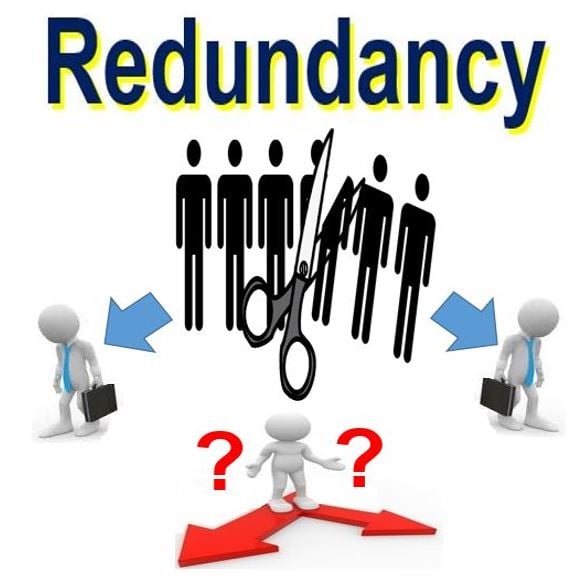Who Pays Redundancy Money? A Detailed Guide for Employers and Employees
Who Pays Redundancy Money? A Detailed Guide for Employers and Employees
Blog Article
Checking Out the Interplay In Between Company Redundancy and Business Versatility for Future Growth
In the vibrant landscape of today's business globe, the intricate connection in between firm redundancy and organizational versatility arises as an essential aspect for continual development and success. Companies typically deal with the difficulty of striking a fragile equilibrium in between maintaining a level of redundancy to reduce dangers and promoting flexibility to react quickly to the ever-evolving market needs.
Relevance of Company Redundancy
Company redundancy is an essential aspect that improves organizational durability and mitigates operational risks. By integrating redundancy steps within the organizational framework, companies can better endure unforeseen disruptions and changes in the business environment. Redundancy acts as a strategic barrier, permitting business to adjust and react properly to unanticipated difficulties without jeopardizing vital operations.
One key aspect of the importance of firm redundancy is its duty in making certain connection during times of crisis. When encountered with unexpected modifications or emergencies, redundant systems, resources, or personnel can tip in to preserve essential functions and protect against extensive disruptions. This connection not only safeguards the company's online reputation and client count on yet additionally reduces financial losses and functional downtime.

Techniques for Organizational Versatility

Another important approach is spending in technology and facilities that can sustain versatility and scalability. Applying electronic devices, automation, and data analytics can streamline operations, enhance effectiveness, and supply important understandings for educated decision-making. Furthermore, producing adaptable organizational structures that enable for quick modifications to market characteristics and consumer demands is essential for staying affordable in a swiftly advancing setting. By proactively recognizing possible disturbances and possibilities, companies can proactively adjust and flourish in an ever-changing business landscape.
Balancing Redundancy and Adaptability
Attaining an unified balance between functional redundancy and organizational flexibility is extremely important in navigating the complexities of a vibrant company environment. Redundancy within a firm offers a safeguard, making sure continuity and stability in procedures. Nevertheless, an unwanted of redundancy can cause inefficiencies and prevent versatility to transforming market conditions. On the various other hand, organizational flexibility permits companies to respond immediately to external interruptions and seize brand-new opportunities. Striking the ideal equilibrium between redundancy and flexibility is a delicate process that needs a deep understanding of the company's goals, sector dynamics, and danger resistance.
To achieve this balance, business need to carry out routine evaluations of their procedures to determine locations where redundancy is needed for threat reduction and small business closing employee rights uk where flexibility can drive technology and development. Applying adaptable frameworks, cultivating a society of continual discovering and renovation, and motivating open communication throughout all degrees of the company are crucial methods to balance redundancy and versatility effectively. By aligning these 2 essential components, firms can place themselves for lasting development and success in an ever-changing organization landscape.
Instance Research Studies on Adaptation Success
In examining instances of effective business adjustment, it comes to be evident that the interplay between operational redundancy and versatility is a specifying variable in shaping durable services. A DVD rental solution, Netflix showed impressive adaptability by transitioning into a streaming platform when digitalization disrupted the industry. These case studies highlight the importance of operational redundancy coupled with business flexibility in fostering long-lasting development and competitiveness.
Building Resilience for Future Development
Structure durability for future growth calls for a tactical placement of operational processes with market characteristics and arising trends. Firms should adjust to altering environments by promoting a culture of adaptability, technology, and continuous improvement.
Additionally, fostering solid relationships with stakeholders, such as consumers, employees, distributors, and the community, is essential for keeping and weathering unpredictabilities trust and support throughout rough times. Reliable communication and transparency play an essential role in structure strength, as they help straighten assumptions and help with cooperation in browsing uncertainties.
Moreover, companies need to prioritize discovering and growth initiatives to upskill staff members and equip them with the needed devices to adjust to changing situations. By buying their labor force, firms can enhance their versatility and agility, eventually reinforcing their strength for lasting future More about the author development.
Conclusion

In the dynamic landscape of today's organization world, the complex relationship in between firm redundancy and organizational adaptability arises as an essential aspect for sustained growth and success. Firms frequently deal with the Go Here obstacle of striking a delicate equilibrium in between maintaining a level of redundancy to minimize risks and promoting versatility to respond promptly to the ever-evolving market demands.To attain this equilibrium, firms need to conduct normal analyses of their operations to determine locations where redundancy is required for threat reduction and where adaptability can drive advancement and development.In conclusion, the interplay between business redundancy and business flexibility is crucial for future growth. Building durability through a combination of redundancy and versatility will make sure that firms are prepared for the obstacles of the future.
Report this page